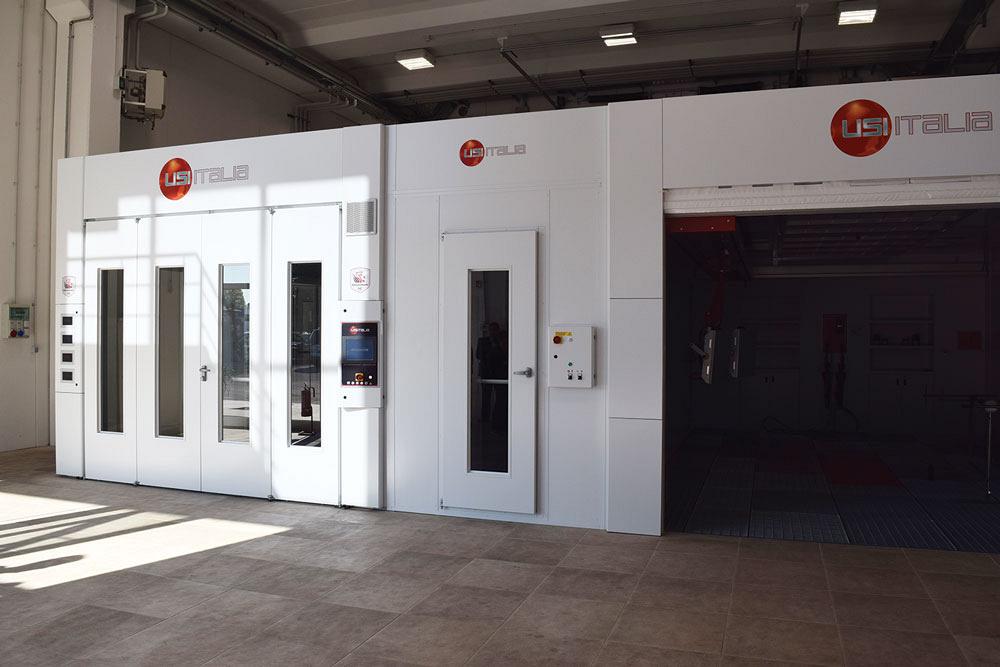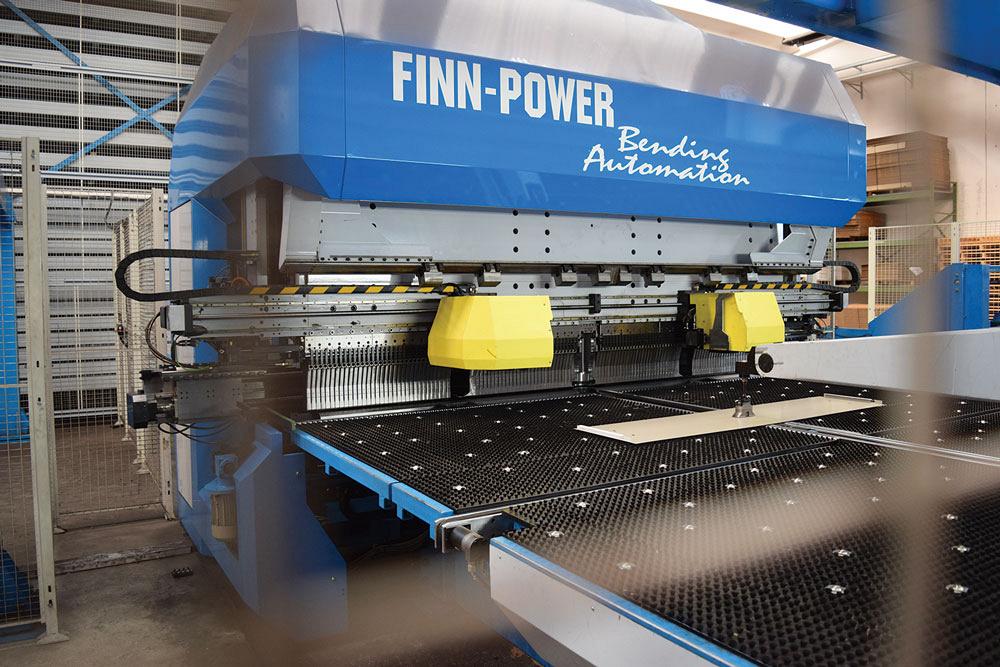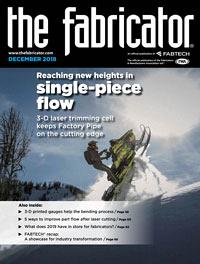Contributing Writer
- FMA
- The Fabricator
- FABTECH
- Canadian Metalworking
Categories
- Additive Manufacturing
- Aluminum Welding
- Arc Welding
- Assembly and Joining
- Automation and Robotics
- Bending and Forming
- Consumables
- Cutting and Weld Prep
- Electric Vehicles
- En Español
- Finishing
- Hydroforming
- Laser Cutting
- Laser Welding
- Machining
- Manufacturing Software
- Materials Handling
- Metals/Materials
- Oxyfuel Cutting
- Plasma Cutting
- Power Tools
- Punching and Other Holemaking
- Roll Forming
- Safety
- Sawing
- Shearing
- Shop Management
- Testing and Measuring
- Tube and Pipe Fabrication
- Tube and Pipe Production
- Waterjet Cutting
Industry Directory
Webcasts
Podcasts
FAB 40
Advertise
Subscribe
Account Login
Search
Industry 4.0 in action throughout Italy
Italian manufacturers embrace digital trends, automating fabricating processes to free up creative time for customer needs
- By Rob Colman
- January 3, 2019
- Article
- Automation and Robotics

Cecomp builds BIW parts for both Aston Martin and the Renault Alpine in its Piobesi plant. The two cars are pictured here in front of the shop’s 2-D fiber laser, which includes sorting capabilities.
In the past couple of years, Industry 4.0 has been the buzzword du jour across Europe. The name simply refers to the trend of automation and data exchange in manufacturing systems; shops are automating their production lines and monitoring part flow in such a granular manner that the smallest of bottlenecks can be addressed just in time.
In Italy enthusiasm for Industry 4.0 has been bolstered by the federal government, which hopes adoption of Industry 4.0-empowered technology will make its manufacturing sector more competitive. The country’s 2017 Budget Law introduced new tax incentives and increased existing incentives for companies investing in technological and digital systems that fit the 4.0 model. These incentives included hyper-depreciation on tangible operating assets and super-depreciation on intangible operating assets, tax credits for R&D, and support for SMEs and innovative startups.
The FABRICATOR visited a number of Italian manufacturers this year, and it’s clear from those visits that a desire to acquire the benefits of a fully connected shop has sparked the imaginations of a number of business owners. And for those already on the path of automating and digitally monitoring the shop floor, it is pushing them even further.
Modeling Future Growth
In 1978 Giovanni Forneris founded CECOMP (Centre of the Experimental Construction of Models and Prototypes) to meet the needs of automakers worldwide for high-quality production of models and functional prototypes. Even before the founding of CECOMP, Forneris had broken new ground in founding a model shop that was completely independent of a specific manufacturer and helping to create the first CNC machine designed to mill epowood models.
That spirit of innovation continued into the new century as the company adapted to technological advances. One-offs are still an important part of the company’s history and business; they showcase the depth of knowledge in the company and allow staff to experiment with manufacturing techniques and industry lightweighting efforts. A perfect example of this is the company’s involvement in the manufacture of the one-off all-titanium body Icona Vulcano.
At the same time, as the need for models and prototypes shrank, the company added capabilities to its core skill set so it now produces small and medium-sized runs of premium automobiles, as well as larger-run production of specialty electric vehicles for car-sharing programs in Europe and beyond.
Giovanni Forneris’ legacy is now being carried forward by his sons, Paolo and Gianluca Forneris, who are very much involved in the day-to-day operations of the company, which now comprises three plants in Italy; one in Slovenia; and a design center called ICONA for modeling and prototyping in Shanghai, Turin, and Los Angeles.
Giovanni Forneris’ name is also that of the company’s newest plant in Piobesi, named at its grand opening in 2017 in honor of his pioneering spirit. The plant is designed for small and medium-sized production runs in aluminum, which include production of the Renault Alpine, as well as aluminum bodies for Aston Martin and other specialty automotive producers.
The Piobesi facility is meant to reflect the founder’s innovative spirit both in its output and its production methods, which follow the ideals of Industry 4.0. For instance, the plant was purchased with stamping lines already in place. But CECOMP upgraded the presses by fitting them with robotic arms that can load and unload parts and connecting them to the full Industry 4.0 reporting system of the factory.
In fact, there are few areas of the facility that aren’t touched by some form of automation. All machines on the floor are connected to the main office, so at any time management can see production numbers on the floor. Also, all customer product information arrives in a 3-D format from the client, which is then fed to the production floor.

Here we see examples of two assemblies manufacturerd at Cecomp for the Renault Alpine, a rear fender and a door inner.
From the minute aluminum sheet enters the plant, meanwhile, it is stored in a 90-m-long Prima Power Night Train FMS® vertical storage system. Sheet thicknesses vary from 1 mm to 2.5 mm. Part nesting is managed in the office. Sheets are blanked with a laser cutter on the shop’s Prima Power Laser Genius LGF 2040 4-kW fiber laser. They are then separated from their skeletons by a sorting system, which uses vacuum arms to handle and stack the parts and skeletons on separate pallets. Parts are then returned to the Night Train and removed as needed. This system runs 24-7. The fiber laser combines high productivity with flexibility, efficiency, and accuracy thanks to the use of materials such as carbon fiber and synthetic granite. Its efficiency is further enhanced by the high-dynamics linear motors on the main machine axes.
“The value of this part of production is twofold,” said Gianluca Forneris. “The Night Train storage keeps sharp cut aluminum parts safely stored behind a gate, which removes a safety concern. Also, having someone maintaining storage or loading and unloading parts is a low-profile job you don’t need. Any manual work we do at CECOMP needs to be highly skilled work.”
After parts are stamped they are sent to the shop’s three 3-D laser machines—one Laser Next 150, one Laser Next 2130, and one Laser Next 2141, all equipped with Prima Power 3-kW fiber lasers. All the tables give a shop the ability to process one part while loading a second part. The LN2141 has a larger working volume of 4,140 by 2,100 by 1,030 mm. CECOMP has 10 more 2-D and 3-D Prima laser machines at its other facilities.
“The new system [LN2141] appealed to us because it is a very smart machine,” said Gianluca Forneris. “It can recognize the set of the product, the fixturing, and correct as necessary. But the most important thing is that having these three machines in this plant allows us to increase our output substantially. The fiber laser can cut 8 to 9 m/minute in some conditions. To give you an idea of how much the addition of this third machine means: When we started producing the Renault Alpine BIW parts, we were able to produce between 10 and 12 bodies a day. We can now produce 25 a day.”
Robotic gas metal arc welding is used to weld the chassis, which requires no remachining after processing. The Piobesi facility also handles closures assembly and extruded profile milling.
CECOMP’s innovation journey will, of course, continue. Gianluca Forneris points at the potential of additive manufacturing as a tool that could change some of the company’s manufacturing processes. As it stands, the CECOMP team is keen to continue to improve production turnarounds at the Piobesi facility to prove out the value of Industry 4.0 in making small-batch production agile and profitable.
Painting an Industry Success Model
Automotive paint spray booth manufacturer Usi Italia began using automation on its shop floor in 2007 when it installed a fully automated punch/shear/panel bending line attached to an 80-m-long Night Train at the company’s Verona, Italy, plant (sold then under the FinnPower brand, the full line is now sold under the Prima Power name).
The system can process as much as 3,000 tons of sheet metal a year. In 2017 the company ran 1,800 tons of galvanized steel for panels on its paint booth products.
As straightforward as a paint booth sounds, its configuration can be a challenge.
“When I started in the company in 2005, we probably produced 95 percent standard product,” said Michele Stradiotto, sales and marketing manager. “Now I would say 95 percent of what we produce are customized projects. That’s the big difference between us and our competitors.”
As Stradiotto explained, technicians and salespeople must have the technical competence to determine, when looking at a building, how air will flow in and out of the space, and how other aspects of the booth have to be constructed to meet the needs of the client. Although Usi built its name on car paint booths, its product line has been scaled up for such needs as the construction of railcars, aerospace parts, and, in one instance, sailboats (the latter booth measured 40 m long by 12 m wide by 8 m high).
Usi has innovated its products in other ways, such as developing air exchange processes that consume only 11 kW of power compared to its old standard of 22 kW. The company also has developed software that will further automate the painting process itself. In addition, it can stabilize the temperature in its booth in a range of about 1 degree either side of the target temperature for curing.
The company’s automated shop floor serves as the backbone for all this activity.
“The automation of our sheet metal production line adds to the competitiveness of our business,” said Stradiotto. “We were something of a pioneer for production like this. Where robots can’t beat us is in our creativity and finding solutions for our customer. That’s where we put our efforts.” Usi has a team of 20 engineers who work on those innovative processes.
Nests created in the Usi front office based on customer designs are sent to the Night Train that picks material from storage for production.
The punch/shear combination machine is known as the Prima Shear Brilliance model today. The punch has enough room for 70 to 80 tools to power 32 stations. It punches holes and forms parts using hit speeds up to 1,300 hits per minute and up to 35 tons of ram force. An inkjet is used in the Usi shop to mark each part so it can be prepared for installation correctly. The machine also keeps track of tool use so that after 50,000 punches, it instructs the operator to sharpen the tool. The punch has a working area of 4.2 by 1.5 m.
Usi’s system is set up so that a robot can turn a part over to prepare it for processing on the panel bender. Parts are automatically stacked on a pallet after being removed from the panel bender. The whole system can be run essentially lights-out.
Usi has seen a steady 5 percent increase in production levels on the system for several years, except this past year when production jumped 15 percent.
Stradiotto noted the government’s incentives to invest in 4.0-enabled machines today, and he is actively looking for more machines that can complement the work done by his company’s Prima Power system. Already Usi has invested in a robotically manned press brake for larger sheet metal parts that cannot be run on the combo system, but that’s only a first step.
“We want to invest in more machinery like this,” said Stradiotto. “For instance, we would like to invest in a 3-D scanner that we can put inside a building to create a precise view of a space in order to create custom products. This is the direction we’re taking.”
The company is also testing virtual reality technology to assist with after-sales service of its products.
By automating sheet metal fabrication, more time can be spent taking care of end customer requirements.
Lighting the Way to 4.0
Industrial behemoth ABB has been an important player in the encouragement of factory digitalization in Italy. The government called upon the company in 2017 to be one of four “Lighthouses” to serve as benchmarks for the rest of industry. Based on this, the company created seven focuses for its efforts: virtual (paperless) factory operations, autonomous flow of materials, collaborative robot use, predictive maintenance, predictive quality management, smart health and safety management (using sensors to control access to certain areas, etc.), and digital supply chain management. This all complements the company’s 10-year-long dedication to lean/JIT production that it is working to push through its supply chain. According to Fabio Golinelli, advanced processes and technologies manager at ABB S.P.A. Electrification Products Division, the company aims to reach its goals on this campus by 2021.
any of these efforts are on display in the company’s Dalmine, Italy, factories. Three factories on one campus build medium-voltage switchgears for secondary distribution, medium-voltage circuit breakers, and switch disconnectors and contactors. The building producing medium-voltage switchgears has already been transformed with the use of fully automated sheet metal fabrication, among other tools.
The switchgear plant produces about 10,000 units a year and is divided into four sections: subassemblies, picking, main assembly, and testing.
The metal processing line is where the process begins. The Prima punch/shear/bend system, installed in 2016, comprises four main stations. The shop’s vertical Night Train warehouse can manage different sheet sizes up to a maximum 1,500 by 3,000 mm. The storage is connected to a PSBB line that includes an SGe6 punch press with a right-angle shear, C1500 sorting conveyor, SPB buffer, a PSR6 (picking and stacking) robot to manage components flow, and an EBe5 panel bending machine with an unloading system on a roller conveyor served by a high-capacity ABB robot.
According to ABB staff, they are able to use more than 80 percent of each galvanized metal sheet that is processed through the machine. The punch/shear operates 24-7, whereas the shop prefers to run the panel bender only during manned shifts as one in every 10 to 15 parts is checked manually for quality assurance. The shop has integrated a series of scrap boxes that move sideways when they are full to make room for another scrap box, which is what allows the machine to run completely unmanned on weekends. The shop runs 70 percent standardized nests and 30 percent custom jobs. About 300 pieces are produced in an eight-hour shift on the punch/shear.
Production is managed using an in-house-designed MES. For assembly, employees receive information on the kit that they will be working on. Although the shop builds four main product families, there are more than 500 combinations among those families, so proper kitting and instruction are imperative. Likewise, automated carts guide dedicated operators who collect materials for assembly. The carts move to where each material is and shine a light on where to find each part. Materials are then double-checked in two different phases via the MES. Each unit built ends up with a thorough history of its build via operator interaction with the MES.
Once a unit is built and tested, an autonomous vehicle picks it up and moves it to a final testing area, after which it is packed up using an automated palleting system.
Again, although metal fabrication is only one facet of production, almost completely automating the process frees up management time to consider other, more central customer concerns with the final product.
About the Author

Rob Colman
Related Companies
subscribe now

The Fabricator is North America's leading magazine for the metal forming and fabricating industry. The magazine delivers the news, technical articles, and case histories that enable fabricators to do their jobs more efficiently. The Fabricator has served the industry since 1970.
start your free subscription- Stay connected from anywhere

Easily access valuable industry resources now with full access to the digital edition of The Fabricator.

Easily access valuable industry resources now with full access to the digital edition of The Welder.

Easily access valuable industry resources now with full access to the digital edition of The Tube and Pipe Journal.
- Podcasting
- Podcast:
- The Fabricator Podcast
- Published:
- 04/16/2024
- Running Time:
- 63:29
In this episode of The Fabricator Podcast, Caleb Chamberlain, co-founder and CEO of OSH Cut, discusses his company’s...
- Trending Articles
AI, machine learning, and the future of metal fabrication

Employee ownership: The best way to ensure engagement

Dynamic Metal blossoms with each passing year

Steel industry reacts to Nucor’s new weekly published HRC price

Metal fabrication management: A guide for new supervisors

- Industry Events
16th Annual Safety Conference
- April 30 - May 1, 2024
- Elgin,
Pipe and Tube Conference
- May 21 - 22, 2024
- Omaha, NE
World-Class Roll Forming Workshop
- June 5 - 6, 2024
- Louisville, KY
Advanced Laser Application Workshop
- June 25 - 27, 2024
- Novi, MI





























